Many users cropped cameras often complain that it’s difficult to get a good picture from such a camera and that you must use full frame. Many people just drool on full-frame camerasthinking that they can do something improve their photos. And if you really want to shoot a full frame, and at the same time invest a little bag of money to purchase a camera, then this article is just for you.
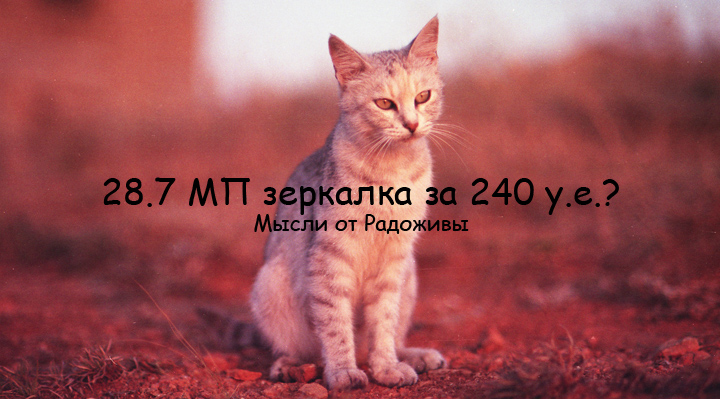
Shot on the same Full Frame :) 28 MP for 240 cu The cat is photographed in the sunset red sun.
Any good photography is based on the desire and skill of the photographer, everything else (including photographic equipment) is just a distraction from the main goal. I am often reproached for advocating to shoot with cheap equipment. I don’t actually do that, I advocate the idea that you can get a good shot from any camera if you want. Of course, the better the technique, the easier and faster the result can be achieved. Those who want to get good pictures get them from anyone, sometimes even the cheapest technique.
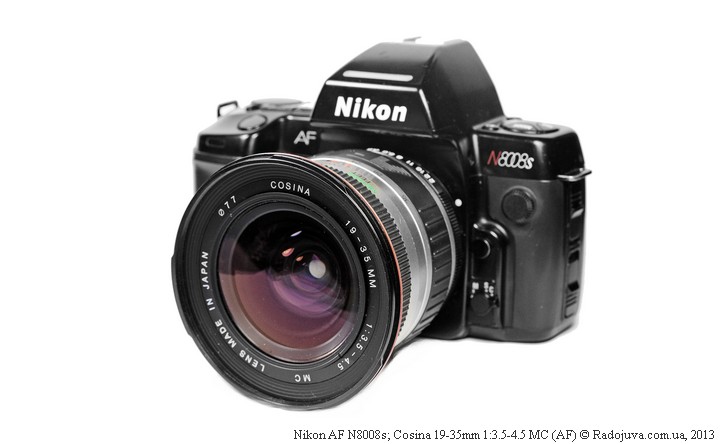
Actually, in this photo almost the whole essence of the article :)
Therefore, if there is a key aspect - desire, then for only 240 cu can:
Shoot with a full-frame SLR camera, with fast automatic focus, good serial shooting with a huge frame buffer, a huge optical viewfinder, nice controls and at the same time take pictures at 28 MP.
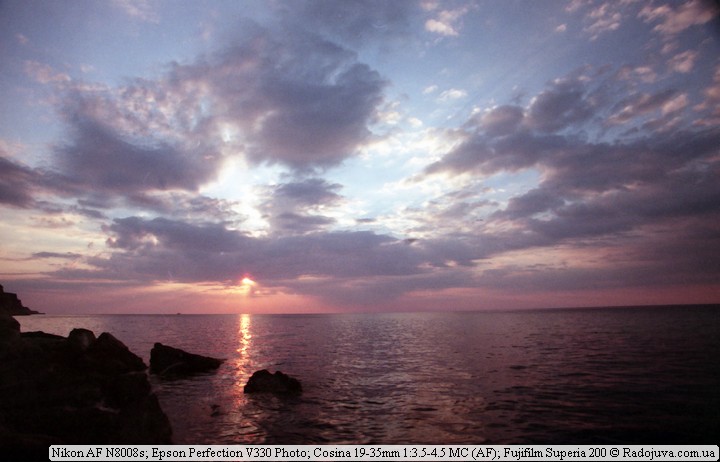
Example photo on my set. Sunset.
The secret is very simple - just use a film camera.
Many readers may think that the film camera is something terribly ancient, incomprehensible to manage, morally obsolete and unsuitable for use in the era of modern monsters Nikon D4 and Canon 1DX. In the expanses of the CIS countries such an impression people have it from the fact that in the Union and on its territory not a single SLR narrow-camera camera with automatic focus was released. Seriously, the old Zeniths do not cause any interest among young people, the main reason for which is the complete obsolescence of technology.

Example photo on my set. Gull
But in other countries long ago let out pretty autofocus analog volatile DSLRs with interchangeable lenses. Moreover, using such a SLR camera is no different from any modern amateur DSLR camera. Nikon D3200 or Canon 600D.
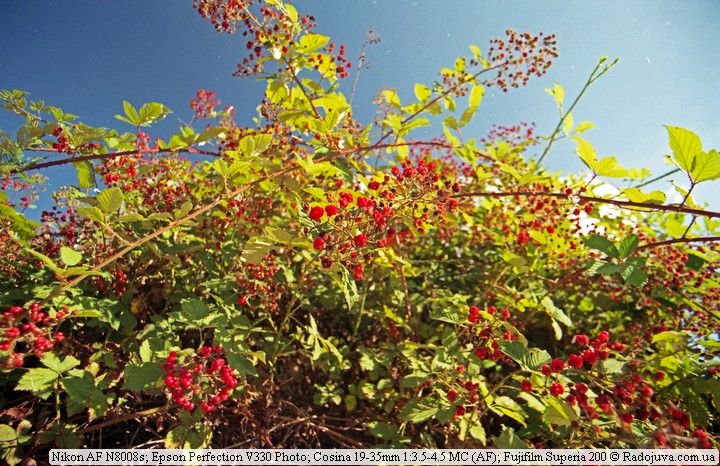
Example photo on my set. Forest Blackberry
I conducted an experiment, which cost me quite inexpensively, as a result of which this kit was assembled here:
- Nikon AF N8008s (also known as Nikon AF F801s) - 400 UAH
- Cosina MC 19-35mm 1: 3.5-4.5 (AF) - 700 UAH
- AA Batteries * 4 - 20 UAH
- 200-frame Fujifilm Superia 36 film roller - 27 UAH with free development
- Epson Perfection V330 Photo Scanner - 650 UAH
- Shipping of the camera, lens and scanner - 80 UAH
Total 1877 UAH or 235 cu In fact, I could save on the lens and batteries, since I have both. The camera, film roll and scanner cost me some 140 cu
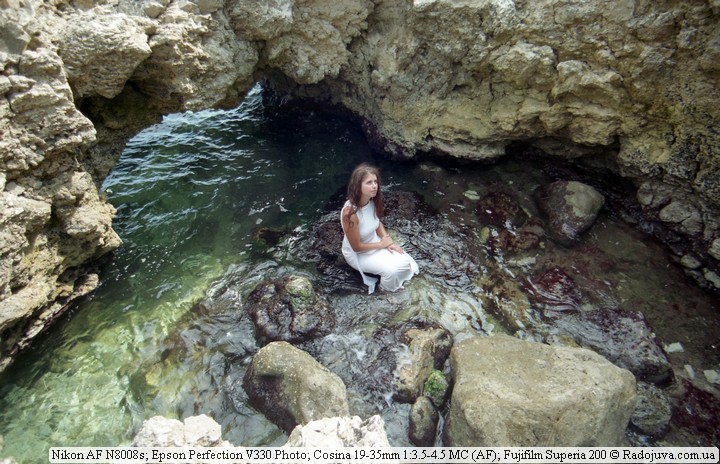
Example photo on my set. Among the stones
As a result, I got:
- A full-frame camera with a shooting speed of 3.3 frames per second. Some amateur cameras have approximately the same shooting speed. Nikon D80, D70s, D3000, D3100, and some professional CZK for 500 cu they shoot even slower, for example, Fujifilm Finepix S5 Pro.
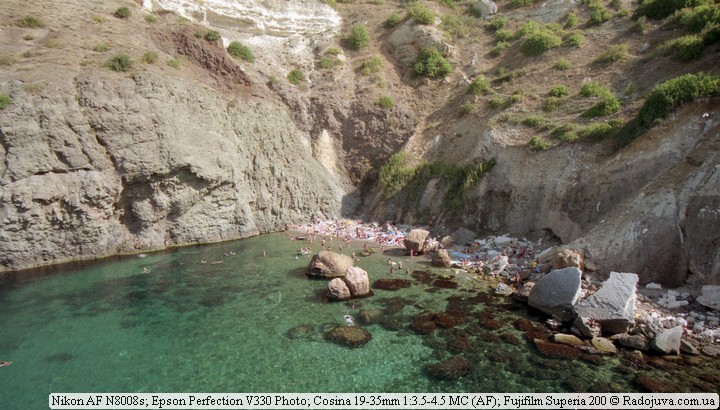
An example of a photo on a film camera. Beach.
- Maximum frame buffer makes 36 shots, for example, Nikon D7100 with the highest quality has frame buffer only 6 shots (RAW, 14-bit, lossless compression).
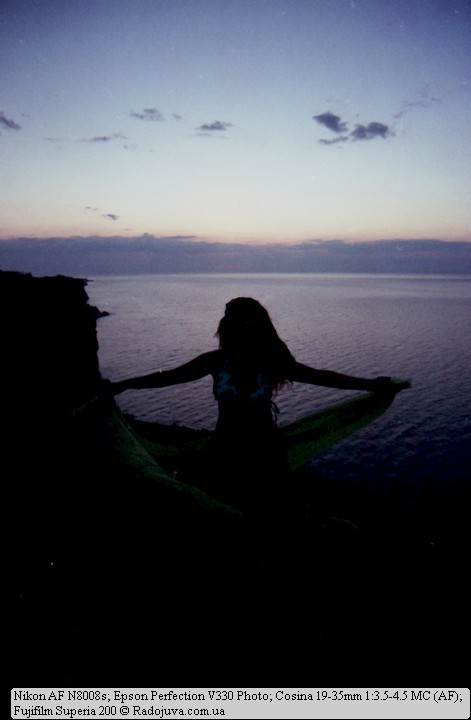
An example of a photo on a film camera. After sunset
- My camera can work out super short shutter speed equal to 1/8000 seconds, which even can not Nikon D600 и Canon 6D.
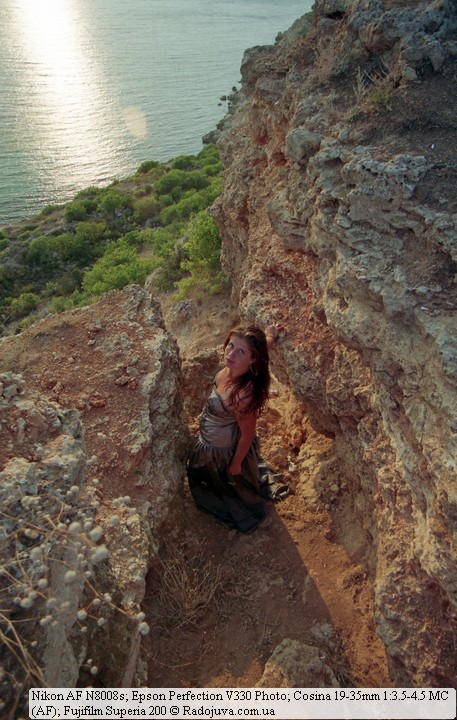
Example photo on my set. Among the stones
- A huge optical viewfinder that never dreamed Canon 70D for 1500 cu Yes, and in itself Nikon AF N8008s very good and durable camera.
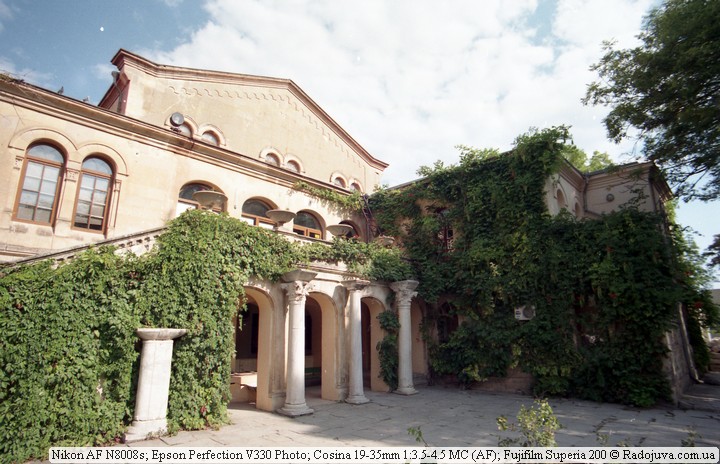
An example of a photo on a film camera. House overgrown with grapes.
- My Nikon AF N8008s it works easily with manual optics - it correctly measures exposure, has an electronic range finder, which very accurately tells about focusing. Even Nikon D5200 for 600 cu can't measure exposure with AI-S lenses.
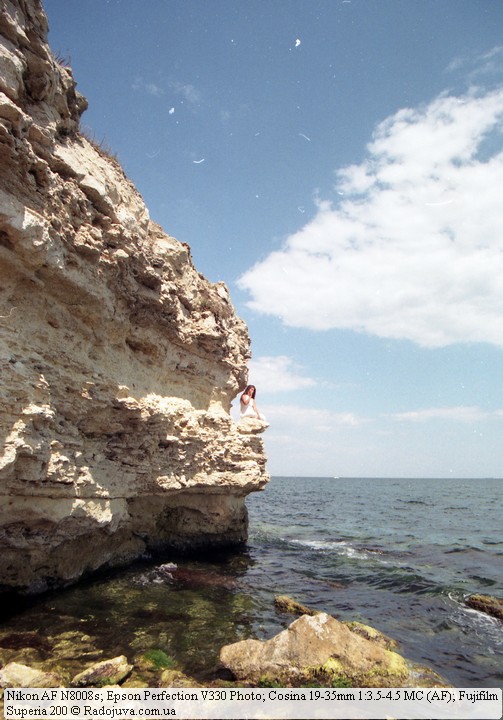
An example of a photo on a film camera. Sitting on the rocks.
- Very nice LCD in JVI, its brightness is physically (not electronically) dependent on the light source. The brighter the source - the brighter the LCD, which allows you to always clearly see the camera settings in JVI. For example, on many CZKs, I don’t see the LCD at all on a bright day or when shooting in backlight.
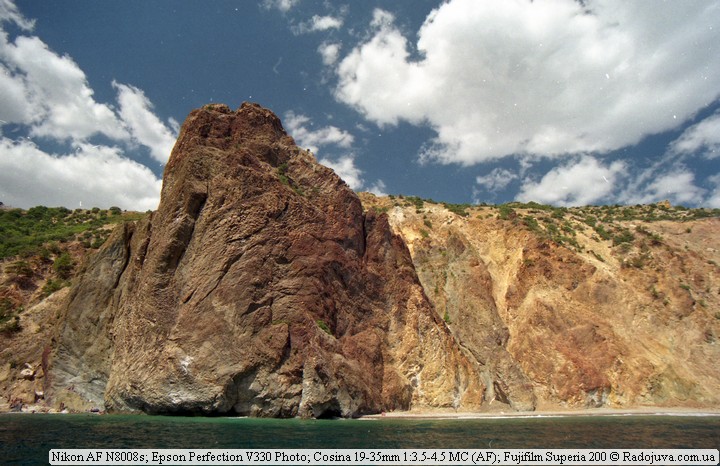
Example photo on my set. Photo from the boat
- Camera control is almost the same as that of any other Nikon CZK. When shooting, you don’t feel any difference, the whole setup is on a monochrome display.
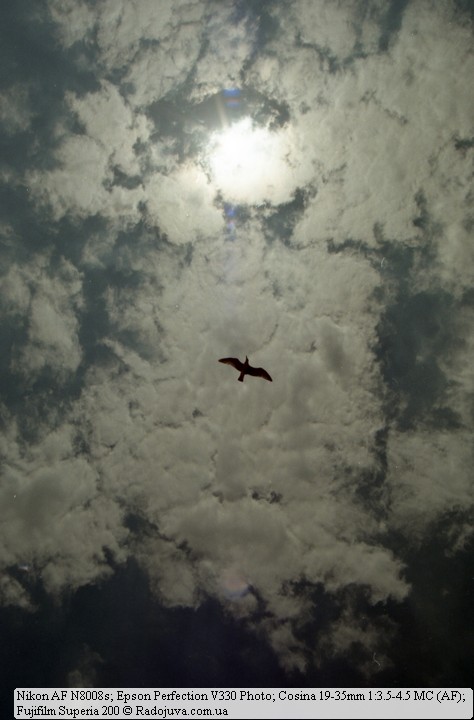
An example of a photo on a film camera. Gull
- Lens Cosina MC AF 19-35mm 1: 3.5-4.5 I just bought it for fun. 19mm at full frame can be safely attributed to an ultra-wide range of focal lengths. The lens focuses terribly fast, and with it you can create amazing pictures. To get the same viewing angle as this cheap lens gives out, on Nikon cropped cameras you should use the expensive Nikon 12-24mm F / 4.0.
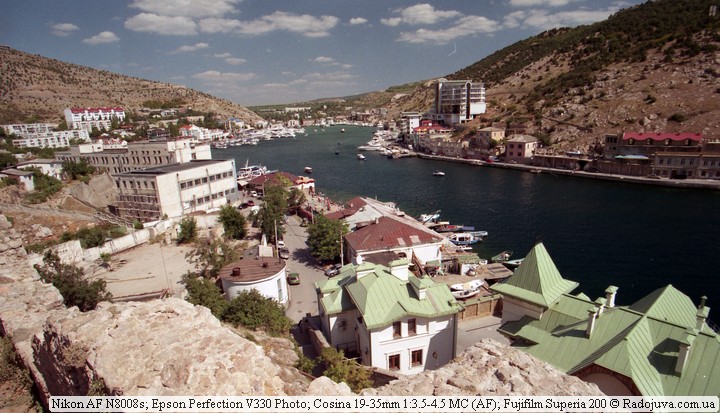
Example photo on a film camera
- A scanner in the house is also useful, for example, to digitize old photographs for an album. For example, you can scan your school diaries, and share old memories on social networks. In any case, the scanner will not be redundant.
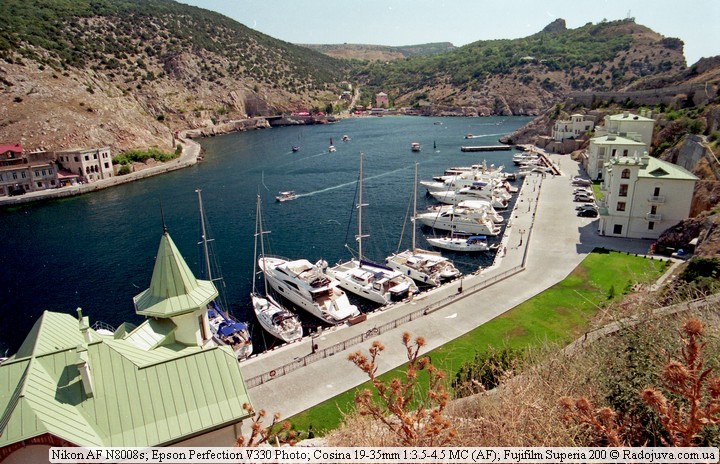
Example photo on my set. Yachts
- The scanner allows you to obtain images with 48-bit color depth. This means that each channel is encoded with 16 bits. Most 'cool modern cameras'can encode a channel using only 14 bits, and receive 42 bits at the output. Theoretically, with my scanner, you can get 64 times more shades than with any DCC.
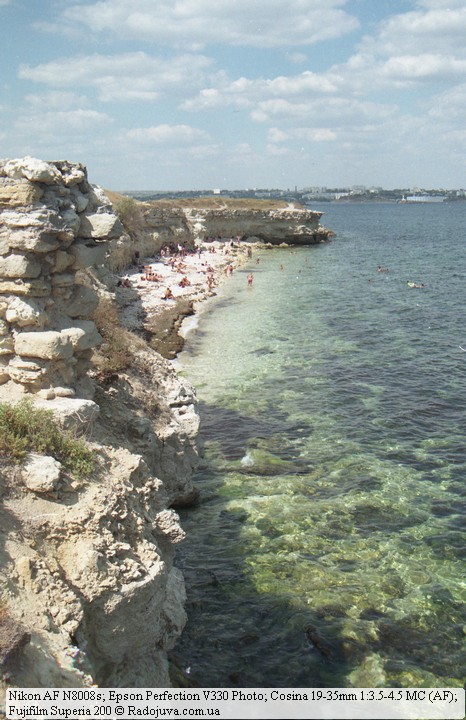
An example of a photo on a film camera. Shore
- Of course, my set has more disadvantages than advantages :), but I’ll keep silent about them in this article.
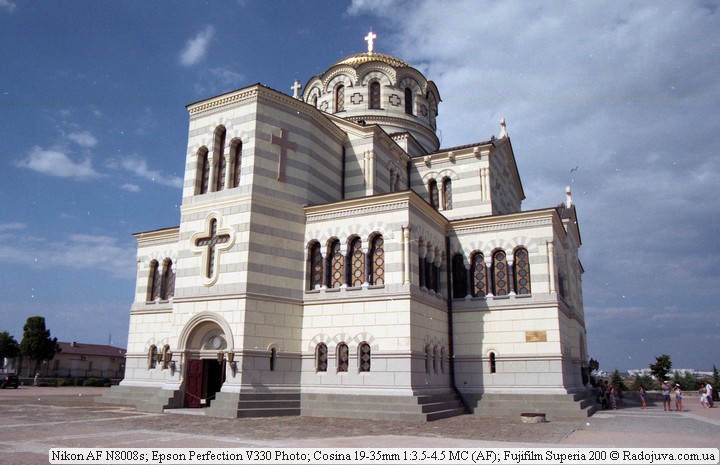
Example photo on my set. Temple in Chersonesos.
The following describes where I got 28 MP from the old film camera.
Of course, the 28MP figure in the article is a duck. But you can still get this figure in this way - the film has a physical frame size of 24mm * 36mm. Let's find the area of the film in square inches, since the parameters of the scanner are indicated in inches.
1 centimeter = 0.393700787 inches
1 square centimeter = 0.15500031000062 frame inches
1 square centimeter = 100 square millimeters
1 square millimeter = 0.0015500031000062 cpi
As a result, the film area is24mm * 36mm * 0.0015500031000062 = 1,339202678405357 sq. inch
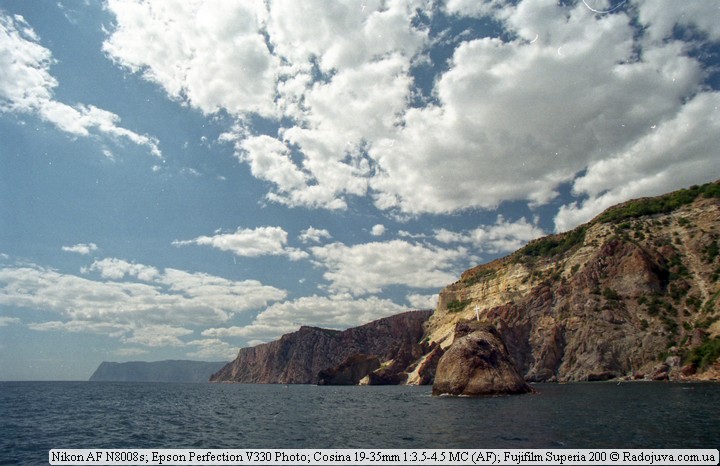
Example photo on my set. Landscape
The area of the film is 1,339202678405357 sq. inches. My scanner scans at 4800 pixels per inch, or 23 pixels per square inch. From 040 square inches of 000 pixels per square inch, 1,339202678405357 23 040 pixels are obtained, which is approximately equal to 000MP.
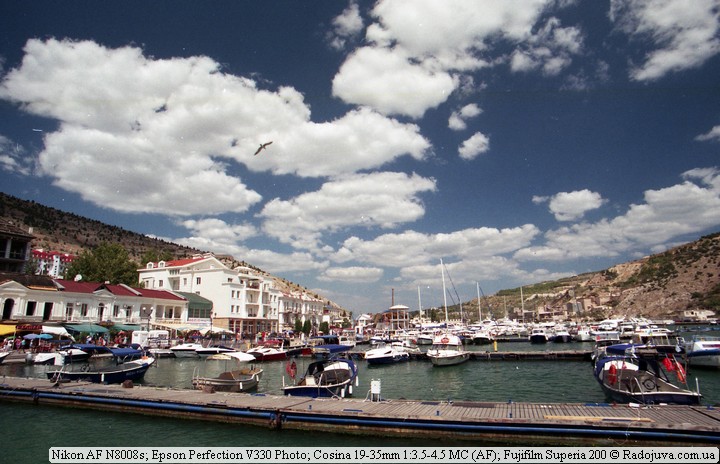
Example photo on my set. Balaclava
If your scanner has a different DPI, then the number of pixels when scanning a film frame can be calculated using the following simple formula:
DPI * DPI * 1,34
Some scanners in specifications have different DPI in height and width, for example, 4800 * 9600 is indicated in the specifications of my scanner. In fact, I can only scan at 4800 * 4800 or 9600 * 9600. The last option is half interpolation. The 'maximum possible DPI' is often indicated, for example 128000 is simply bloating the final image using a mathematical method of interpolating pixels, these numbers should not be paid attention to.
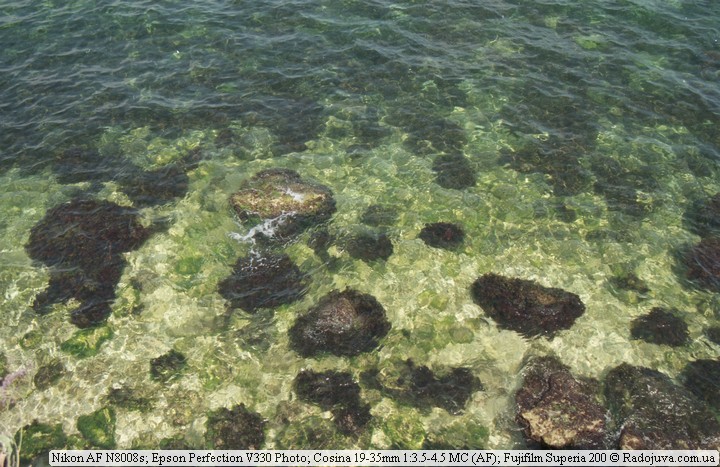
Example photo on my set. Near the shore
The simplest scanners with a slide adapter have 1200dpi, as a result, such a scanner can be squeezed out of one film shot:
1200 * 1200 * 1,34 = 1 929 600 (total about 2 MP)
I indicated '28MP camera' in the title of the article, since my Epson Perfection V330 Photo cuts off the edges of the frame a little when scanning and we end up with images not from the entire area of the film, but from a slightly smaller area. For example, a scanner often creates images like 6639 * 4319 pixels. Those who are chasing megapixels have already realized that from such a simple set you can squeeze these (or not these?) megapixels almost as much as Nikon D800 (a D800 costs almost 3000 cu).
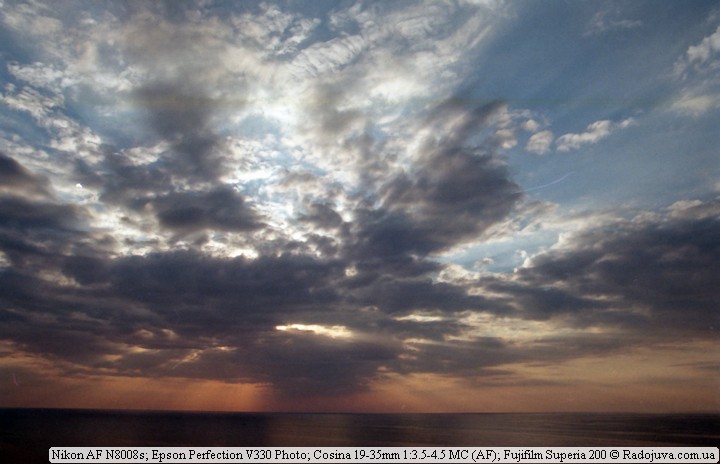
Example photo on my set. Another sunset
By itself, for serious work, such a set is no good. But the task before me was quite amateurish. For 240 cu I can enjoy a full-frame camera with convenient professional-grade control, an ultra-wide-angle lens that helped me out well on vacation and in addition I have a scanner that is convenient for scanning mail invoices :). I do not advocate fussing with a film camera, but once again I want to emphasize that there is absolutely no difficulty in working with a good analog camera. And instead of being discouraged that someone full frame, you can easily and simply shoot a full frame yourself.
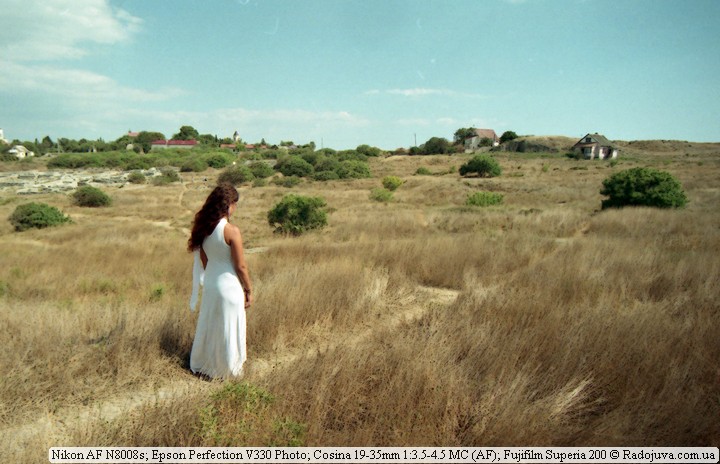
Example photo on my set. Road.
More sample photos (1400 pixels long)
Conclusions:
All of the above applies not only to my set. I brought my film set as real worldly example. Now buy used Nikon or Canon's autofocus analog camera is easy, the same goes for good-old lenses. The same story with the scanner.
Comments on this post do not require registration. Anyone can leave a comment. Many different photographic equipment can be found on AliExpress.
Material prepared Arkady Shapoval. Training/Consultations | Youtube | Facebook | Instagram | Twitter | Telegram















































Here in the comments came across a link about the dynamic range of the film. For the most “dynamic” Portra 160 NC - 10 steps. And they still need to be obtained when scanning / printing. And if you look at the most “dynamic” representative - Nikon D800. Its range is 14.33 stops at 75 ISO. Compared to approximately the same sensitivity - 13.65.
So the figure in the "digital" aspect will be better.
In general, film and digital cannot be compared in a utilitarian way - these technologies have gone too far from each other ...
This article does not address the issue of film versus digital. Where do all the commentators go? I ran through the essence of the article in the text itself three times.
Arkady, it was such a serious topic “about pixels” that affected them :) Like “who needs loud operatic voices if there are microphones”.
“The article does not touch upon the question“ film or digital ””, but at every step there are analogies with a figure, starting with the title with megapixels :)
For example:
"Using such a DSLR is no different from any modern amateur DSLR Nikon D3200 or Canon 600D."
“Camera with a shooting speed of 3.3 frames per second. Some amateur cameras Nikon D80, D70s, D3000, D3100 have about the same shooting speed, and some professional TsZK ... "
“With my scanner, you can get 64 times more shades than any digital control center.”
“That from such a simple set you can squeeze out these (or not these?) Megapixels almost as many as the Nikon D800”
So, if you already made a bunch of analogies with the number, then do not be surprised that people began to make inverse comparisons, where the advantages are in numbers :)
I made an analogy of my set with some modern cameras for people who have not seen analog cameras in the eye to arouse interest and clarify some aspects. Specifically, a set: a scanner (about bitness, what does the film have to do with it?), The speed of the camera's burst shooting (what does the film have to do with it?), The ease of controlling an analog camera (what does film have to do with it?). Again you want to suck “film or number?” From your finger. I will have to repeat the essence of the article once again: working with an analog camera is no more difficult than with an amateur DSLR, and for a small amount of money you can shoot with a full-length camera.
I don't suck anything, but the phrase “to shoot with film is no more difficult than with digital” and “this is not a comparison between film and numbers” does not fit very well :)
You wanted to convey to people that shooting on film with an advanced camera is no different from ... the figure familiar to everyone, except for the impossibility to see the result right away. A lot of people really don't know about this and the article is definitely helpful. And according to the quality of the image, everyone will conclude for himself whether the transition is worth it.
Yes, this is not a comparison between tape and numbers. For those who do not understand well, it will be necessary to explain again - “to shoot on film is not more difficult than on digital” means only what is included in this phrase. And the invented comparison of the film and the numbers is just sucked from here, because it is simply convenient for many to see in this only a comparison, and not an explanation by example. I think the demagoguery in the comments to this article will not stop.
Arkadey padskazhi brat what lucshe filmka or cifra? privet is sunny Baky!
Support.
I support. In 2010, bought an expired Fuji-100 film, was released in the 1998 FIFA World Cup. I took a photo of Zenit 122 with different lenses. Considering our situation in Donetsk, I found where to show. The quality is certainly not the same, but the problem of scanning the film was solved simply. In the same laboratory, for 30 rubles, they scanned a film for me and pulled something out in Photoshop. The photo lab scans any film and selectively - 5 rubles. I love working with film. Dmitry and what else would you recommend good film cameras. And what special programs are there for processing photos.
It provokes the beginning of the discussion. And away we go .. :)
Great article! The only pity is that it is perceived as “the battle of the film and the czk” ... well, not everyone gets the true idea of your article. I noticed a small inaccuracy in the line “my printer is scanning”)))
Congratulations, Ark! Brilliantly! I have long discovered that film, which plays the role of only a replaceable matrix, fits perfectly into the era of digital technologies, since after the scanner the further processing is purely digital. I believe that purely mechanical film cameras should hardly be considered "obsolete". They are indispensable in extreme sports: batteries and accumulators are not needed, neither high humidity, nor bitter frost, nor heat are terrible. I remind you of my arsenal; Zenith 3 and 3M (the best of Soviet DSLRs, Zenit-3M, according to one of the authoritative Western experts, is one of the great DSLRs of the golden age of photography), Kiev-19. Both Zenits are on the move (1962 and 1966). Optics: Industar-50 and 50-2, Helios-44 and 81N, Mir-1A and Jupiter-37A. Exposure meters: Leningrad-8 (selenium is in order, it works from “-50 C” to “+50 C”) and Sverdlovsk-6. HP SJ G-3010 Scanner. You can create and process files up to 120 MP.
“Neither high humidity nor bitter frost are terrible” and have you ever worked mechanics in the cold due to thickened grease? And it is not recommended to freeze fabric curtain shutters, even in manuals for cameras, and even more so with age. The resource of these cameras is also not that great, they are alive only because the film capacity does not allow working out the mechanics. One friend of mine went on business trips and filmed a lot - she killed more than one Zenith, the mechanics could not stand it, handled it carefully - everything just really worked out. These hard workers are now at her home, out of order ...
Batteries and accumulators are an even more controversial argument - with a film capacity of 36 frames, you need to carry another bag of film with you, or miss a lot of frames. Yes, now they will swoop in, they will say that there is nothing to photograph everything in a row - so you can not photograph anything at all :)
So independence from food is leveled out by a small stock of shooting, it is difficult to consider it an advantage.
Zeniths are different - "which are proletarian, which are bourgeois ..." (Mayakovsky). Since Zenit-E (after entering the world market), the quality has dropped sharply. My "troikas" are still alive today, although each of them has shot at least 10 films a year since 1965. And to kill Yeshka and later is a simple matter. The frost resistance of the Barnack shutter with high-quality manufacturing (Leiki and Zorkiye-Zenits until 1970) is the same as that of the film (below “-10” it starts to crumble), and more than that of the digital camera electronics, and the resource exceeds that of all others shutters (Leek has about 400 actuations). As for a bag of film, one sniper shot is worth a clip fired into the milk.
“10 films a year since 1965” - a simple count shows that this is about 18 frames. Not so much, by modern standards, so for sure :) Although those cameras that I mentioned shot less than 000 before the breakdown. But I just don't remember the resource from the manual, I remember something about 10 frames ...
It would be interesting to try a film camera with digital film http://re35.net/index.html# Quality should be much higher. But as I understand it, this product has not yet been brought to mind.
There is a finished one - digital backers. But for 35 mm this is too much :)
Medium format - yes, it is relevant there.
It’s such a hot :)) Patent є but I’ll add a dumb one ... I can patent a vichny dvigun with such success :))
There is a super productive engine (or something like that), and the patent (rights and everything related to it) for its use is held by the owners of oil companies. A smart guy appears, who invents it and uses it, and they say to him “uh, brother, you are using our patent technology”. And such a smart guy is taken away from his development (and / or simply imprisoned), so that everyone will continue to drive on gasoline, and the oil workers continue to earn money. It's the same in the digital camera world. It's 2013, and not a single new development of matrices. And it is enough even to inflate the Fuji matrix from c3 or c5 to a full frame and we would get extremely interesting equipment. Of course, these are my thoughts out loud, and they don't have to be true.
I shot for very long years on film, now digital, but I can't love the latter :-(. Art in the world has turned into synthetic art, new morals and new values, everything is divided into pixels. The bar for creative development has fallen. Now everyone is a professional photographer, even tablet owner :).
And I thought that art is in choosing the right angle, light, etc., and not in the film. The film and the matrix are just a tool for obtaining high-quality images. If you shot well on film, then you will shoot even better on a number, since its capabilities are much wider.
In, golden words! Namely, the camera is a tool, and the more perfect this tool is, the EASIER it is to get a good result. The result of the PHOTOGRAPHER's work, such as cropping, lighting, and so on.
I write about it all the time, even in this article.
Arkady, you - yes, but among commentators for some reason such thoughts do not often slip through, but more often “I fell in love, and then I cannot” ...
Now, for some reason, too many are worried about the fact that photography has become mass and because of this it is “not the same” that “every second photographer” and so on. Why is that bad? Now the pictures of a hundred years ago are very much appreciated, because they were single. Much has escaped history forever, only stories remain. So even though the present time will be captured "from the heart", in 50 years it will be interesting to look at it.
I am very sorry that photography was so little widespread in the past. I would like to see a lot ...
The boom is caused by the availability and ease of management of technical means. I think the interest in affordable DSLRs will go exactly like the boom on cameras on phones.
And I think that will not be lost :)
Evolution does not stand still. After all, there used to be a great demand for digital compacts as the most affordable means for obtaining digital photos. Now cameras in phones are stepping on digital compacts, and quite strongly - the demand for them is constantly falling. DSLRs became available, and now the majority of the “family camera” is not a digital compact, but a DSLR. And this is good, because with the same “curvature” of the photographer, the DSLR allows you to get better quality photos.
This is according to the law of dialectics. Where there is a large quantity, there is poor quality. Few working photographers, a lot of "post-processing".
Thank you very much for the new reading. It's nice that your blog is regularly updated with reviews and bright thoughts. I shoot myself with Nikon F90x, the possibilities are almost the same as those of the camera from this review. It is not a full frame itself that attracts, but a slightly wider dynamic range. The picture quality is pleasing to the eye. Moreover, I shoot not only for myself, sometimes they order a photo shoot on film. Film portraits can be a highlight in any family photo album.
Here, for example, near the window.
http://img-fotki.yandex.ru/get/9154/193940978.c/0_b817c_39c7a45e_XL.jpg
Well… .Arkady wrote an excellent article about how you can easily and inexpensively expand the range of interests of a photographer and try something new. And then a pancake came! Are you shooting digital? So shoot further. I also shoot at it. No need before anal pain, express your IMHO about the film. If you don't want to, no one forces me. And for example, it was very interesting for me to read, because I myself have been thinking about it for a long time. And not in order to bury the figure in the film, but in order to broaden my horizons. You damn comrades, with your squeals, squeeze it only to the point of view ...
Arkady, thank you so much for the article and don’t listen to anyone. A photographer is always an ambiguity, which is why there arose interest in this issue. I shake my hand!)
I join the words above :)
From myself I will add:
There are people who are not interested in the technical quality of the image as such. They are interested in the PHOTOGRAPHIC METHOD of obtaining an image. Someone shoots on film, someone on a slide, plate, even on a matchbox. You just need to love photography, love to take pictures, do it as a pleasure to yourself and to people.
It's good when the technical quality is not interested to a reasonable extent. And then you see an awesome sunset over the water, for example, but filmed with a mobile phone, everything is in terrible noise and blur - low technical quality prevents you from seeing all the beauty.
All this is very interesting to read! I suppose they are the same. if not large, debates were conducted in the olden days, during the formation of the photo process in general. Well. remember, digital is as young as a teenager. There is still something to improve in it and, believe me: a generation of photographers in 15-20 years will have in their hands a completely different technique in perfection, and our sophisticated “hazel grouses” for hundreds of thousands will be simply anachronisms. But even then there will be many apologists for the “old” figure, who consider it more emotional, lyrical ... This has always been the case. I've been professionally engaged in photography for 34 years now and I will say frankly: often we, "old people", grumble at a number and praise an analogue because working with film is difficult and unpredictable, time consuming and cumbersome, requires many years of persistent perfection and the development of intuition, many manual unique based on the results of operations and other things and other things ... This fun is for professionals and very inquisitive and persistent amateurs. What affects the commercial services market. Now, almost 100 percent of those who have bought themselves a DSLR from time to time, occasionally or constantly try to make a living with it, and thus oversaturate the market for offers of photo services incredibly, and this cannot but anger professionals who have achieved success for many years by hard work and improvement, often starting with manual processing of films and stuffing huge bumps on this path. The last bad thing is that almost all the creative potential of the photographer was spent on getting a good negative and a print from it; more often than not, there was not enough strength for “art”. And in this sense, digital photography freed the photographer from a host of problems, just as it freed a farmer's tractor from a horse with a plow. It remains to really pay attention to photography, to which I call all the readers of this blog, and to which I have, alas! - it will not come, but it should be ...
I repeat once again: film, which plays the role of only a replaceable matrix, fits perfectly into the era of digital technologies, since after the scanner the further processing is purely digital. I believe that only this way is promising for film. and we - "old men" (I have been in photography for half a century) do not need to grumble, but to master new technologies. By the way, I also shoot digital and - imagine! - with great pleasure. True, by alien digital cameras, and now I am “trudging” from the amazing color rendering of the 2-megapixel matrix of my Samsung GT-S5300 with an ultra-wide-angle (about 20 mm in 35 mm equivalent) fix.
A good article, very natural photographs, yet film is film in a good way. And why there is no mention in the article on digital cameras for old cameras. I met a couple of times on Ibei used and not too expensive.
And what does the digital face have to do with this article? or can they also be bought for $ 200?
Article detector !!! Excellent! ))) I sympathize with you Arkady - you try to convey the idea to people, but they do not see the trees behind the forest. I wish you success!
The article is very necessary and useful. Many people who know the film photograph probably thought about digitizing the film and made their choice in favor of the Central Control Commission. Foil with the film is a lot and expensive, and the development in the labs is bad. The figure spoiled us with the fact that you can shoot a lot and without restrictions. It seems to me that this factor is often crucial.
I always read your articles with interest, emphasizing in them something new for myself, thank you Arkady for your work
be healthy and bless you all.
Thank you :)
You know, Arkady, and in fact you have read my thoughts. I am, sorry, a “pentaxist”, desperate to wait from my favorite full-frame company, I went practically the same way as you did in your experiment: I use a film camera as a “full frame”. I have several of the latter, including a completely mechanical one. Here is only a problem with lenses for film cameras, because for “Pentax” in our photo shops, both “native and non-native” lenses, mostly for crop. Yes, the film is becoming a museum rarity, alas ... And this is exactly what you need, moreover, without the "congenital diseases" of the Bayer matrix. PS It's bad that Foveon cooperates only with Sigm * oh and doesn't want anyone else sell neither your matrices nor a license for their production
Nikon (for sure) and Canon (for any one) have developed new types of matrices. But they are not used, and according to patents they are not allowed to be used by others.
Waited for a similar article)
I even thought of offering you a test of my nikon F 90)
if interested - write, I indicated the soap)
oops, inattentively read the article)
sorry, posts can be deleted)
The discussion turned out to be very lively. And I shoot with digital, and at the age of forty I mastered the computer, and digital. But I carry the film, just like that, for myself. An old Canon T-50, a newer three hundredth, recently bought for 450 UAH. with battery grip and 28-90. 28-70 3.5 \ 4 on it becomes wonderful, fixes are different ... Not as advertising - in Donetsk there is a shop in the Shevchenko cinema, there is always a film that will normally be developed and printed. And the fuss with the film is sometimes less than with the digital - take it and pick it up. Expensive, of course, inconvenient - you can't get 1500 frames for a wedding. Not because it is unrealistic, but because no one will pay for it. The film could not stand the competition not in quality, but in convenience and accessibility. Many old photographers have left the profession without mastering the number. You need to be able to take pictures and keep up with the young. And the photographs from the film are still different ... Not better and not worse, but warmer, perhaps ... Sori for many letters and indistinct content ...
The film can no longer be considered separately from the number, because the films are usually numbered! Yes, and it is impossible to know what “warmth” is without knowing “cold” ...
People who shoot on film do this not because of the full frame, but because of the “warmth” and “liveliness” of the film. This is a lifestyle!
What a coincidence. Recently I also tried to try a full frame film. I scan the market for film devices, namely nikon, so that lenses fit with czk. I found such a device - Nikon F65 for 2 sput (60 usd). Is it a good option ?, or look elsewhere (for example, Nikon F801 and F90X met at 5tyr (160 usd))? Thanks in advance for your authoritative opinion.
PS A late film (normal) apparatus - Smena8m is still at school, soap dishes don't count ...
Well Arkady, you hellish Saton, annealed! I would also suggest to buy black-and-white fot and enlarger crocus for high-quality development.
It turns out I'm not alone. I recently bought crocus for two hundred hryvnias. I had a square with a color head, and this one bought a regular, round one. and a bw film. Bw from the film is not at all the same as from the numbers.
IMHO Interesting pictures are obtained when printing pictures directly from the film. After scanning the film, the photos are somehow dull. This is especially evident in the sunset photo from this article.
Which monitor do you use?
buy a decent scanner and write an article: - "How to shoot with Hassel for $ 500"
I’m not going to write such an article for you :)
By this, Mr. Petroff, you acknowledge that the quality of the images does not keep up with the film. This is also evidenced by the return of Kodak to film production and his intention to resume the production of film cameras.
I didn't say anything about the quality ... I mean that the topikstarter is very disingenuous ... and its "starter kit" for "ridiculous money" with each film (3-4 good shots) will become $ 10 more expensive.
A dozen films and a camera will become twice as expensive.
But I’m shooting :), but I’m not breeding demagogy :)
Did you mean the bankruptcy of Kodak?
When developing a film in a minilab, defects in the form of scratches and light dots (traces of unremoved air bubbles) are almost inevitable. You can delete them in any photo editor. In some cases it is more convenient to use more specialized and therefore more convenient editors instead of cumbersome and rather clumsy Photoshop and GIMP. Polaroid Dust & Scraych Removal is very convenient, where all these defects are removed literally "in one fell swoop."
Film should be dealt with only for the soul or if there is a demand for you as a “film” photographer. And so: let's say a roll of film is 200 rubles. For example, a month we shoot 5 photo sessions of 4 rolls in 36 frames. In a month, 4000 r. For two years, 96000 rubles. And that's just the film! And the price of Nikon D800 turns out And this is for 17 thousand frames. And eight hundred will work two hundred. And I don't think that in the hands of an amateur (and even more so a pro) from the film, the photos will be better! Let's face it - “film” is a state of mind, not a way to get an image!
Those. not at all 28 MP (film will give a maximum of 12MP) and not at all for 240 cu )
Read “between the lines”:
Maybe then it was worthwhile to emphasize the real advantages of the film, for example, the dynamic range. In the article there is not a word about him, but from the comments I realized that the film is very wide (well, of course, you can also see from the pictures themselves).
Oh, an article about the existence of film autofocus cameras with simple controls, and what a penny you can shoot in full frame, which many amateur photographers want. Otherwise, the article will turn into a “digital film”. Instead of spreading offtopic here, I recommend to everyone who has never shot on film - take it and shoot. Anyone who did not shoot digital - also, take and shoot. Then any ambiguities disappear immediately.
Class.
Thanks Arkady. I did not know that there are autofocus filmmakers. As it turns out, not quite for a penny. Those who shot digital will not go away on tape, who listened to mp3 will not return to the gramophone, alas.
The film very well teaches to take pictures, ran all youth with the zenith of ET, out of 36 frames 3-5 unsuccessful, traveled with him all over Ukraine, when you know that you will not return soon and there are not many frames, I really do not want to be mistaken. And the figure, clicked on a bunch of trash, then in the best case a third remains, yes there is a shutter resource, but you don’t really think about it until it comes time to change. My opinion is to myself, with the number I am too lazy to seize the moment and especially follow all the parameters, because there is also photoshop! I had autofocuses of the minolta, kenon, but still I’m back to Zenith 19, maybe I'm a pervert, I have a photo enlarger, I myself print photos, it costs about five times more than on a printer. But I still do not personally put the film and the oak chambers to a level below the figure for myself.
5 ++
For the overwhelming majority of commentators, the thought does not go further than understanding the meaning of words in the text - well, since there are adjacent words about “digital” and “film” in the text, then we will suck it up, but what is the meaning and what the author wanted to say there is nobody worries ...